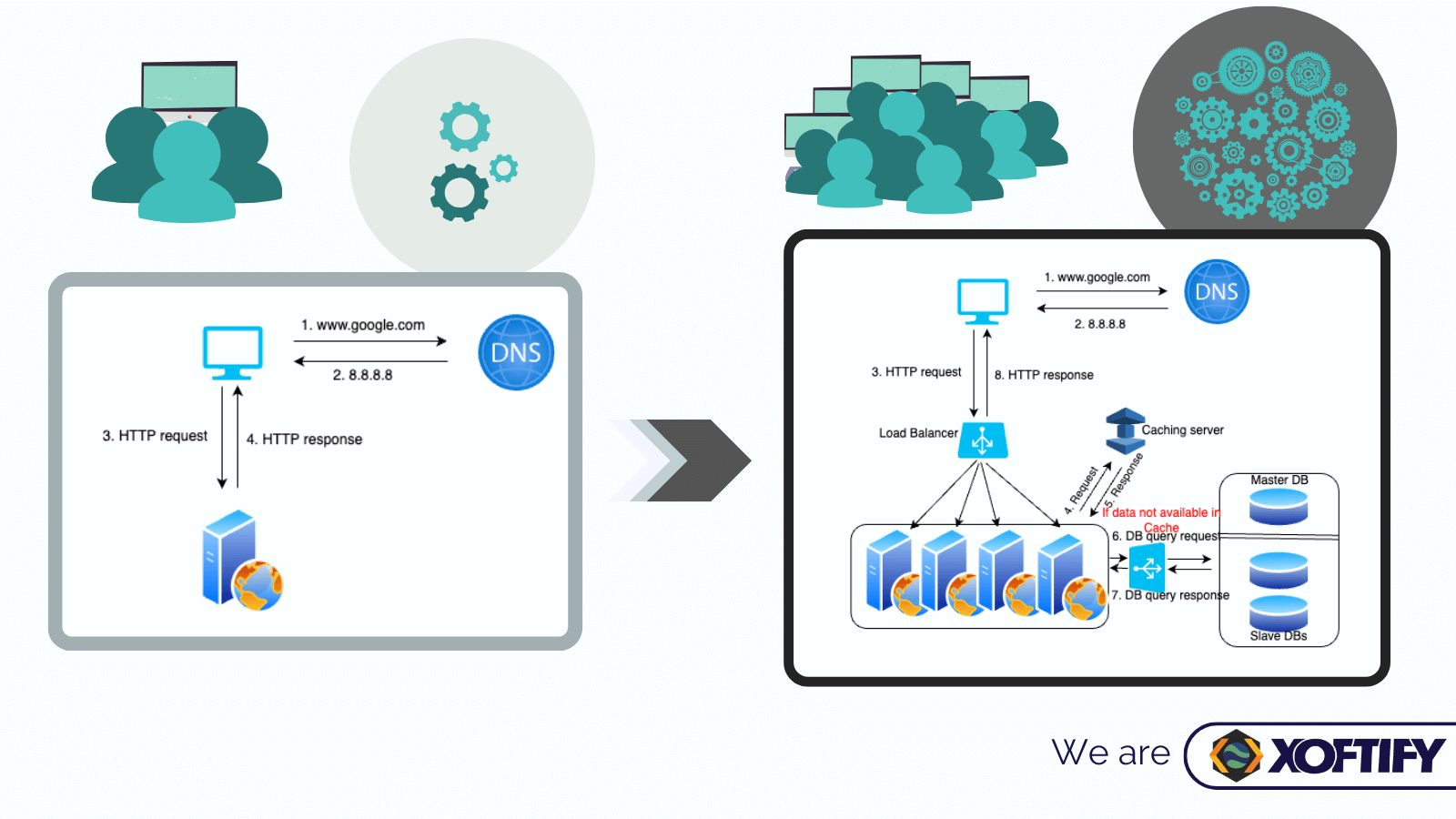This is a comprehensive guide on scaling a system to handle a million plus users. As the digital landscape continues to evolve, the ability to seamlessly accommodate increased user demands becomes pivotal for any successful web application.
In this article, we will learn the details of
By exploring each of this scaling ideas and techniques, you’ll gain valuable insights into building your system a robust, resilient, and high-performance systems capable of meeting the challenges posed by a massive user base.
Whether you’re a seasoned developer or an enthusiast, this will explore the principles and best practices that empower systems to thrive in the dynamic realm of modern web applications.
Structure of a basic system.
In a fundamental system architecture, three key components collaborate seamlessly:
a DNS server,
the user device(s), and
a singular web server.
When a user initiates a request to access the web server, the first interaction transpires with the DNS server. It resolves the user-specified domain name to the corresponding IP address of the web server. Subsequently, with this IP address, the user device directs its request to the web server.
The web server contains all the components like the database, backend functionalities, caching mechanisms etc. This consolidated structure forms the backbone of the system, enabling efficient processing of user requests and seamless delivery of web content.
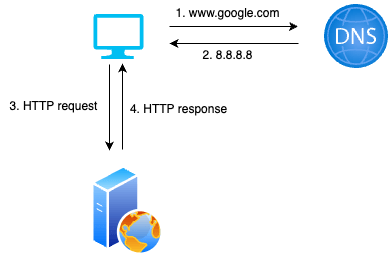
As a web application gets more data, it needs more storage space. To handle this, a smart way is to
separate the storage part from the web server and set up a special database.
This way, the server doesn’t have to deal directly with handling lots of data. Doing this not only makes it easier to handle more data but also makes the system more flexible and easier to maintain.
Then choosing the right kind of database is a crucial decision for a web application. There are different types, like traditional ones good for organized data, and NoSQL ones better for handling lots of unorganized data. When picking, it’s essential to think about things like how much data you have, the way you’ll be asking for it, and how fast you need it. This helps in making sure the database fits well with what the web app needs.
By separating the web server and the database, each can focus on its own job. The web server handles how the app works, while the database takes care of storing and getting data efficiently. This is considered a good way to set up modern web applications. It not only makes the app work better but also makes it ready to handle and do scaling in the future.
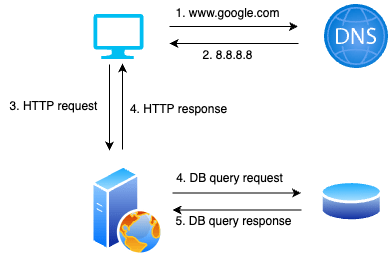
Server Scaling
Indeed, as the demand for a web application intensifies, the imperative to scale the infrastructure becomes paramount. Scaling strategies typically fall into two categories: vertical scaling and horizontal scaling.
Vertical scaling, also known as scaling up, involves increasing the capacity of a single server to handle a greater workload. This is achieved by upgrading the server’s hardware, such as adding more powerful CPUs, increasing RAM, or expanding storage capacity. Vertical scaling is a straightforward approach that can be effective for certain applications, especially when a single, robust server can accommodate the growing load. However, it may have limitations in terms of scalability, as there’s an upper limit to the capacity a single server can provide.

Horizontal scaling, or scaling out, addresses the limitations of vertical scaling by distributing the workload across multiple servers. In this approach, additional servers (nodes) are added to the existing infrastructure, each handling a portion of the incoming requests. Horizontal scaling provides enhanced scalability and fault tolerance, making it a preferred strategy for handling substantial increases in traffic. Load balancing mechanisms are often employed to distribute requests evenly among the multiple servers, ensuring efficient resource utilisation.

Introducing Load balancers
In the realm of horizontal scaling, where multiple servers collaborate to handle escalating user requests, the pivotal role of a load balancer cannot be overstated. Acting as a meticulous traffic conductor, the load balancer assumes the responsibility of receiving user requests and intelligently distributing them across the server cluster using predefined load balancing methods.
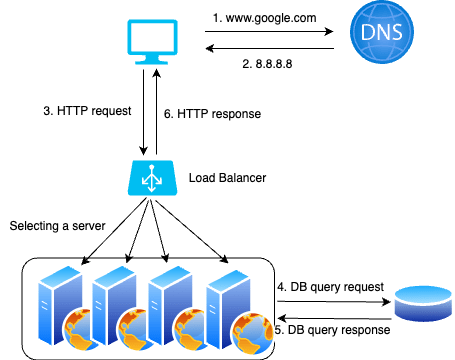
This not only ensures an equitable allocation of workload but also mitigates the risk of any single server bearing an undue burden. As the user remains oblivious to the intricacies of the server infrastructure, knowing only the IP address of the load balancer, an additional layer of security is established. The load balancer serves as a protective shield, preventing direct public internet exposure for individual servers, thereby fortifying the overall system’s robustness, scalability, and responsiveness.
Multiple Database instances
In our current system, a single database instance holds all our data. However, if this lone database instance crashes due to a power outage, our servers lose access, resulting in an inability to serve users. To mitigate this risk, we can implement a horizontal scaling approach for the database, similar to what we did for servers. Unlike servers, database scaling involves a master-slave setup, where the master instance processes write requests, and slave instances handle read requests. The synchronization between master and slave instances, known as database replication, enhances performance, reliability, and overall system availability.
Despite these improvements, a challenge arises when servers need to decide which slave database should receive a particular request. To address this, we introduce a database load balancer. This load balancer takes charge of accepting requests from servers and efficiently redirects them to the appropriate database instances.
However, another potential issue arises if the master database instance crashes. In such a scenario, the system becomes incapable of processing write requests. To counter this, one of the slave instances is automatically promoted to become the new master. Several algorithms exist to select the most suitable slave instance for this promotion, ensuring a seamless transition in case of a master database failure. This comprehensive setup not only enhances the system’s reliability and availability but also establishes a robust failover mechanism for unforeseen circumstances.
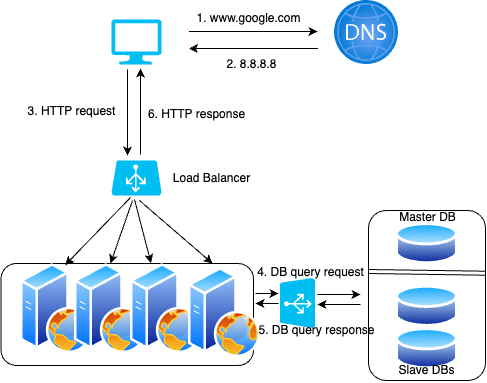
Introducing Caching systems
With our system now resilient to crashes and outages, a new optimization opportunity comes to light. Currently, servers send requests to databases whenever a user requests data, a process known to be resource-intensive and a potential contributor to increased response times. To address this, we can implement a cache between the servers and databases. A cache serves as a temporary storage area for frequently accessed data, usually stored as key-value pairs.
When a server requires data, it can first check the cache. If the required data is available in the cache, the server retrieves it without the need to query the database, thus reducing response times. In cases where the data is not present in the cache, the server sends a request to the database. Once the data is fetched, it is brought into the cache for future use.
It’s essential to note that there are different types of caches, and careful consideration is required during the system design phase. Factors such as eviction policy, expiring policy, and consistency requirements play a crucial role in optimizing the effectiveness of the cache implementation. This thoughtful approach ensures that the cache serves its purpose effectively, contributing to a more responsive and efficient system.
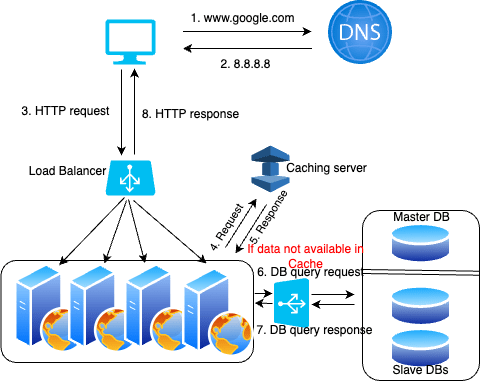
Use of CDN
While caching significantly aids in reducing response times, a challenge remains. Consider a scenario where a user in Finland wishes to access a service hosted on a server located in the US. In this case, the user’s request must traverse the distance to the US, and the response must travel back to Finland. This geographical separation introduces latency and negatively impacts user experience.
This is precisely where Content Delivery Networks (CDNs) come into play. A CDN comprises a geographically distributed set of servers specifically designed for delivering static content. CDN servers store static elements like images, videos, HTML, and JavaScript files. When a user visits a website, their request is directed to the CDN server nearest to them. If the CDN server possesses the required data, it can promptly serve the content to the user. Only if the data is unavailable in the CDN cache does the CDN server request the main servers to deliver the content. Once retrieved, this data is stored in the CDN, ensuring swift delivery if the same data is requested again by the user.
In essence, CDNs significantly enhance the speed and efficiency of content delivery, particularly for static elements, by strategically positioning servers closer to the end-users. This optimization mitigates the impact of geographical distances and fosters a more seamless and enjoyable user experience.
Conclusion:
In this guide on scaling a system for one million users, we’ve covered crucial aspects of system architecture and optimization strategies. Starting with the fundamental structure, we explored scalable database solutions, load balancing, and the importance of caching systems in reducing response times.
The discussion extended to horizontal scaling for servers and databases, emphasizing fault tolerance and enhanced scalability. Database load balancers and failover mechanisms were introduced to address potential challenges.
Caching systems were identified as key to mitigating the cost of database queries, with considerations for eviction policies and consistency requirements. We also highlighted the strategic use of Content Delivery Networks (CDNs) to address global accessibility challenges, improving content delivery and user experience.
This guide serves as a concise roadmap for architects and developers, providing essential insights and best practices to ensure optimal system performance in the dynamic landscape of web applications with large user bases.
